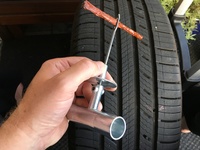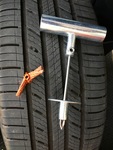 |
| Angelika/Mike Schilli |
|
Michael Somehow, Angelika and I have a special talent for constantly getting the tires of our cars flat. At least once a year, it happens that some screw or, recently in Angelika's case, even a part of a rusty old pair of scissors gets stuck in the tire, causing it to quickly deflate. Even in Germany, this happened to us two years ago during a visit. The rental car tire went flat, and we had to drive back to the branch at Munich Airport on the autobahn with the spare tire on, going 80 km/h. A true highlight of our driving skills!
The procedure for dealing with flat car tires is already routine for us here in the US: jack up the car, put on the spare tire, drive to the tire shop, and get it fixed. However, some American friends told me some time ago that you can also fix tires yourself here with repair kits that cost around 10 dollars. So, I preemptively ordered such a patch kit from Amazon and stored it carefully.
A few days ago, it finally happened: The Integra was noticeably tilted in the garage, and upon closer inspection, it turned out that the air had escaped from the right rear tire. A wood screw was deeply embedded in the tread, and I thought to myself: I'll try fixing this myself now.
The patch kit was held in a bright orange plastic box and contained two martial-looking corkscrew-like tools, along with about 40 pieces of what I call adhesive worms. These are brightly orange cotton cords, about 4 inches long and 1/4 inch thick, heavily coated with a very sticky adhesive. To repair the tire, you first remove the sharp object that caused the mishap, then you use the first corkscrew to pierce a hole and then roughen it with vigorous up-and-down movements, as the tool shaft has a fine grooved texture, like a file.
Then the repairman takes one of the 40 adhesive worms from the pack and symmetrically threads it into the second corkscrew, which has an eyelet at the bottom that opens up like a spring when pressure is applied downward. The tire repairman now folds the adhesive worm in the middle and forcefully stuffs it into the hole using the corkscrew, but not all the way to the end. Instead, he leaves about an inch of both sides of the adhesive-soaked cord sticking out at the top. Then he slowly and carefully pulls the corkscrew out upwards. As he does this, the eyelet of the corkscrew inside the tire opens up and releases the worm. The hole is thus plugged, and the resulting protrusion of the worm ends on the tire surface can either be trimmed with scissors or left as is to be smoothed out by tire wear during driving. Through the chemical miracle of vulcanization, the hole and the worm fuse into an airtight plug, and the tire is now airtight and repaired.
However, this method should only be used if the hole in the tire is not at the tire edge, because otherwise it could weaken the tire structure and lead to unsightly burst tires. Additionally, you can't accelerate to highway speeds with a patched tire, but in America, the speed limit is 75 mph max anyway. So far, the plug has held up well, and I still have 39 spare plugs left, so I'm ready for the next flat tire.













